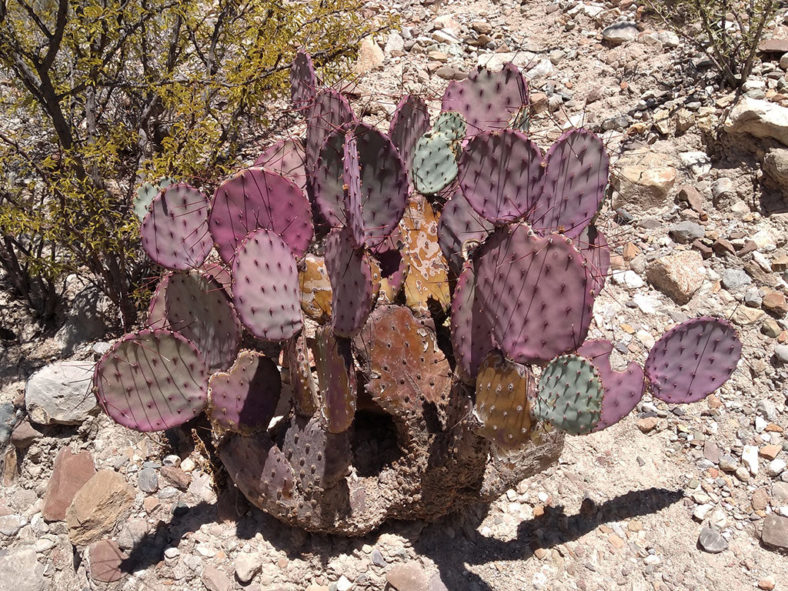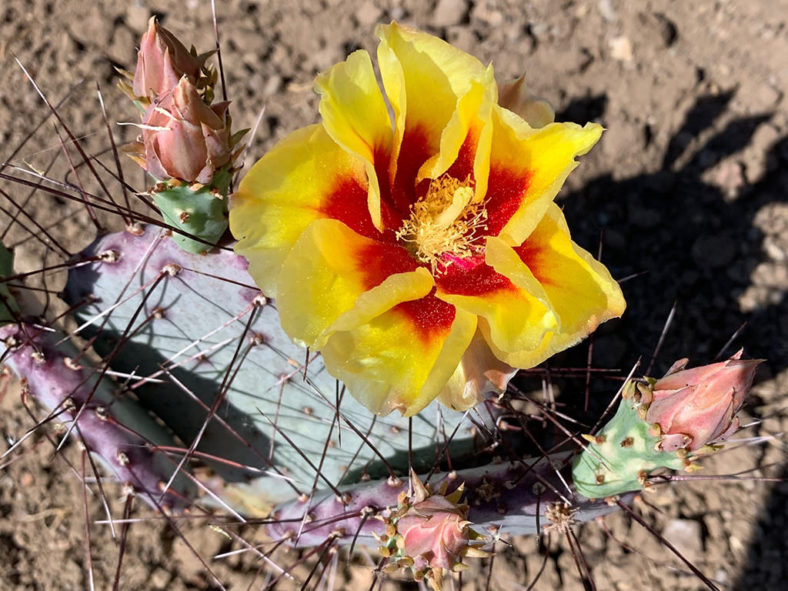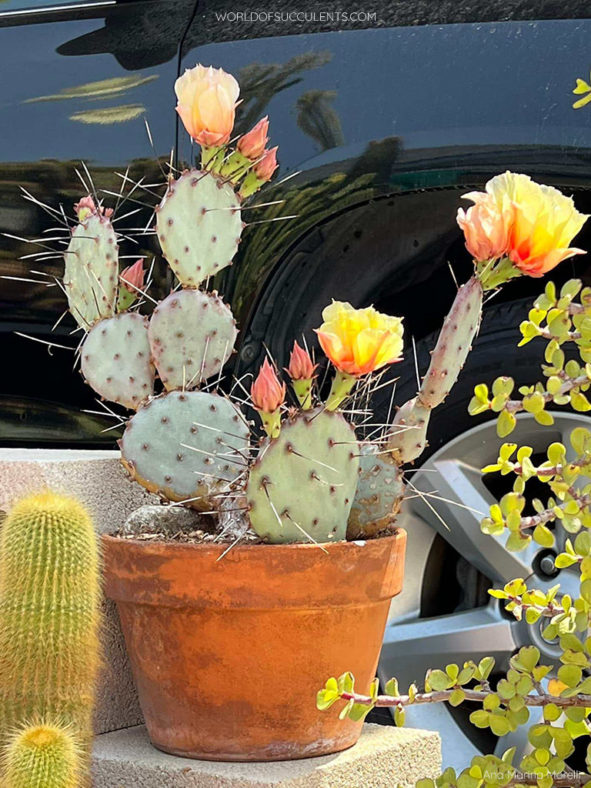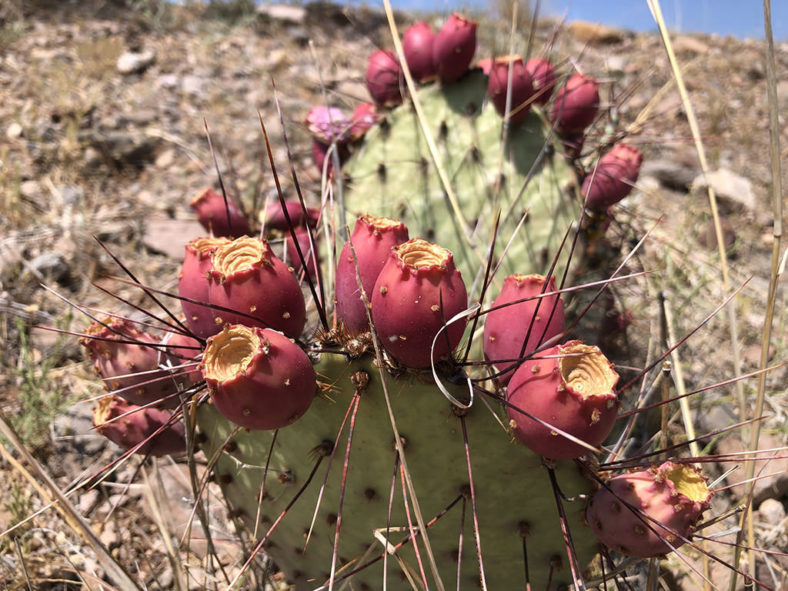Opuntia macrocentra is highly prized for its vibrant stem and flower colors, making it a favored choice for drought-tolerant gardens and potted displays.
Scientific Name
Opuntia macrocentra Engelm.
Common Name(s)
Black-spined Prickly Pear, Long-spined Purplish Prickly Pear, Purple Prickly Pear, Black-spine Prickly Pear, Blunt-spine Prickly Pear, Long-spined Prickly Pear, Long-spine Prickly Pear, Martin's Blunt-spine Prickly Pear, Purple-tinged Prickly Pear, Reddish-purple Prickly Pear
Synonym(s)
Opuntia violacea var. macrocentra
Scientific Classification
Family: Cactaceae
Subfamily: Opuntioideae
Tribe: Opuntieae
Genus: Opuntia
Etymology
The specific epithet "macrocentra (pronounced mak-roh-SEN-truh)" means "large centers" and refers to the long central spines in areoles on the upper one-fourth to one-half of the pads or only on the upper margin.
Origin
Opuntia macrocentra is native to the United States (Arizona, New Mexico, Texas) and northern Mexico (Sonora, Chihuahua, Coahuila, and Durango). It grows on sandy desert flats, rocky hills, or valley grasslands at elevations between 2,000 and 5,000 feet (610 and 1,520 m).
Description
Opuntia macrocentra is a shrubby cactus with erect to decumbent branches that consist of green segments (pads) with purple coloring near the areoles and along the margins. It can grow up to 3.3 feet (1 m) tall. The purple color becomes more evident under drought or cold stress. The pads are flat, egg-shaped to subcircular, and can reach up to 8 inches (20 cm) in diameter. The areoles bear 1 to 4 reddish-brown to almost black, at least basally, central spines and many reddish-brown to yellow glochids. The spines are typically found on the uppermost areoles and can grow up to 4.8 inches (12 cm) long.
During the spring and summer, Opuntia macrocentra produces yellow flowers with a striking red center. The flowers can reach up to 3.2 inches (8 cm) in length and nearly equal in diameter. The edible fruits are spineless, red to purplish, inversely egg-shaped to barrel-shaped, and contain pale purple pulp and yellowish seeds. They can grow up to 1.6 inches (4 cm) long and 1.2 inches (3 cm) in diameter.

How to Grow and Care for Opuntia macrocentra
Light: Opuntia macrocentra thrives in full sun, but some shade during midday and afternoon can prevent sunburn in hot climates. When grown indoors, it works best in a window that receives sunlight for 6 hours a day.
Soil: This cactus requires a well-draining soil mix. You can use a commercial cactus potting mix or create your own.
Temperature: Opuntia macrocentra is highly tolerant of high temperatures and prefers cooler temperatures in winter. It grows best in USDA Plant Hardiness Zones 8a to 10b, with average minimum winter temperatures ranging from 10 to 40 °F (-12.2 to 4.4 °C).
Watering: From spring to fall, water moderately and let the soil dry out completely before watering again. In most areas, rainfall will be enough for established plants. If potted, never let the container sit in water. Suspend the watering during the winter.
Fertilizing: Opuntia macrocentra does not need fertilizer when planted in the ground. However, it will benefit from fertilizing during the growing season when grown in a container. Apply a water-soluble fertilizer. Suspend feeding during the winter when the plant goes dormant.
Repotting: Repot only when the cactus becomes potbound or is too large and unstable in its container. Choose a slightly larger container with drainage holes at the bottom. The best time for repotting is late winter or early spring.
Propagation: You can propagate Opuntia macrocentra by stem segments or seeds. The easiest method is using stem segments, which yields faster results. Take stem segments in early summer for best results, and sow the seeds in late spring.
Learn more at How to Grow and Care for Opuntia.
Toxicity of Opuntia macrocentra
Opuntia macrocentra is not toxic to humans or pets. However, keep the plant away from pets and children as it has harmful spines and glochids that may cause skin irritation.
Links
- Back to genus Opuntia
- Succupedia: Browse succulents by Scientific Name, Common Name, Genus, Family, USDA Hardiness Zone, Origin, or cacti by Genus
Photo Gallery
Click on a photo to see a larger version.


